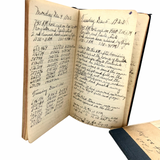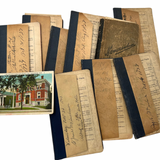1929-1934 Archive of a Depression-Era Beat Cop’s Log Books and Ephemera Documenting His Patrols of Downtown Boston
10313On offer is an archive of nine logbooks and associated ephemera kept by a Boston police officer patrolling in the downtown core during the Great Depression.
The police officer who kept these log books is Albert Edward Ellis (1897-1986), a patrol officer with the Boston Police Department. Prior to entering the force, Ellis served in the US Army during World War I. He married Irene A. Kelley and they lived in Roslindale, MA with their two children, Jeanne and Albert. Ellis became a Mason in 1925. He kept these logs while working in downtown Boston for the Boston Police Department in his 30s. His badge number was T229.
For each day he works, Ellis notes, at minimum, the intersection at which he is posted, the officer(s) who relieve him on his breaks, and many 6 digit automobile reference numbers of cars he observed. On many days, Ellis’ notes are more in-depth. Ellis makes exceptionally detailed field notes when there are incidents he will need to officially write up and report back at the station. Some incidents he details include handling a pocketbook theft, describing automobile accidents he witnesses, responding to civilian complaints such as open manholes, breaking up fights, and more.
Some excerpts from his notes follow:
“About 11.40 this PM I found the rear cellar door of 754 South street open…Walter’s Candy store…secured same at 1150 PM with Patrolman Locke. Reported to the station 11.55” [Sept 9, 1925].
“About 9 this AM while directing traffic at the corner of Boylston and Exeter street I gave the traffic in Exeter street a hand signal to start... I then heard the horn and noticed a Police car #103 coming…. I then gave a signal for the traffic I had just started to stop and gave the police car a hand signal to proceed…The operator of the taxi which I had started said he did not see the hand signal that I gave him to stop….[the police car] was struck and turned over by a Peerless 20 Century Taxi…” [December 19, 1933].
“... Wanted for murder on Div #16 2 men/#1 – 22 6 150 med comp Blue suit Brown hat/#2 – 22-23 6 150 Brown suit and hat which did not fit at Hotel on Huntington Ave” [Sept 14, 1929].
“I found Bernard D. Mann 40 years old married of 15 Tirrell street Atlantic Mass Laying on the sidewalk in Dartmouth street in front of the library near Huntington Ave. He was taken to Boston City Hospital in the ambulance…[he] was found to be suffering from post Epileptis [sic]…his wife was notified” [Jan 28, 1931].
“Opening day for Liquor End of 18th Amendment” [Dec 5, 1933, Ellis refers here to the end of Prohibition].
Ellis also notes his days off work, vacation days, and breaks during his work day. Ellis’ writing is consistently professional in nature, his personal opinions and feelings never overtaking his professional judgment.
Tipped into several of the logbooks are some additional police-related ephemera including: detailed, completed arrest cards, an envelope with photographic negatives, a form that was supposed to have been sent to the Registrar of Motor Vehicles to record a driving infraction, an official report on an incident (addressed to Captain Perley S. Skillings of Division 16).
The final piece of ephemera provides the one and only hint as to who Ellis was as a person outside of his job - a postcard sent from a friend named “Strip”. In the postcard, Strip refers to Ellis as “Bozo” and makes some jokes that are decidedly politically incorrect.
This archive is an absolutely fascinating glimpse into the work life of a beat cop working in the heart of downtown Boston in the first half of the 20th century. The names of Boston locals and fellow officers paired with the locations mentioned by Ellis provide rich information for those interested in the Boston region. Since Ellis notes his patrol intersection each day, these books may fill in historical knowledge gaps about events in the Boston area during this period of time.
Eight of the diaries measure approximately 6.75” x 4” and contain 60 pages plus an additional two typewritten pages providing instructions to police officers about how to “Ascertain and Note” facts about traffic accidents and the “The Importance of Preserving Fingerprints”. The ninth book measures 6” x 3.75” and contains 140 pages (it is not an official police log book as the first eight are). The diaries are between 90-100% complete. The diaries were kept in 1925, 1929, 1930, 1931 and 1934. Each diary covers a few months of the year. 1929 and 1930 are the most heavily covered with three diaries completed for each of the two years. The covers, bindings and pages of all nine diaries are in good condition. The officer wrote in pencil and pen. All writing is legible. Overall VG.
Please don't hesitate to contact us for more information or to request photos. (Kindly include the SKU, listed on this page above the price, in your e-mail so we can more easily answer your questions.)











